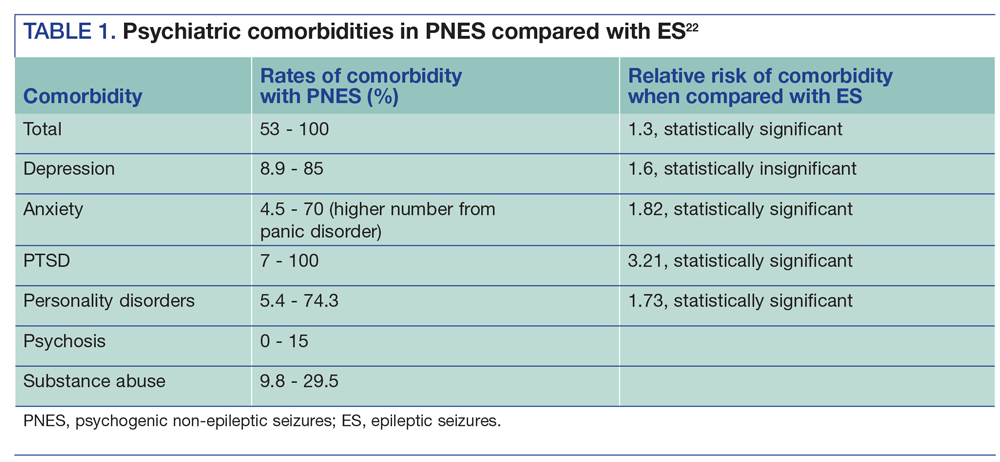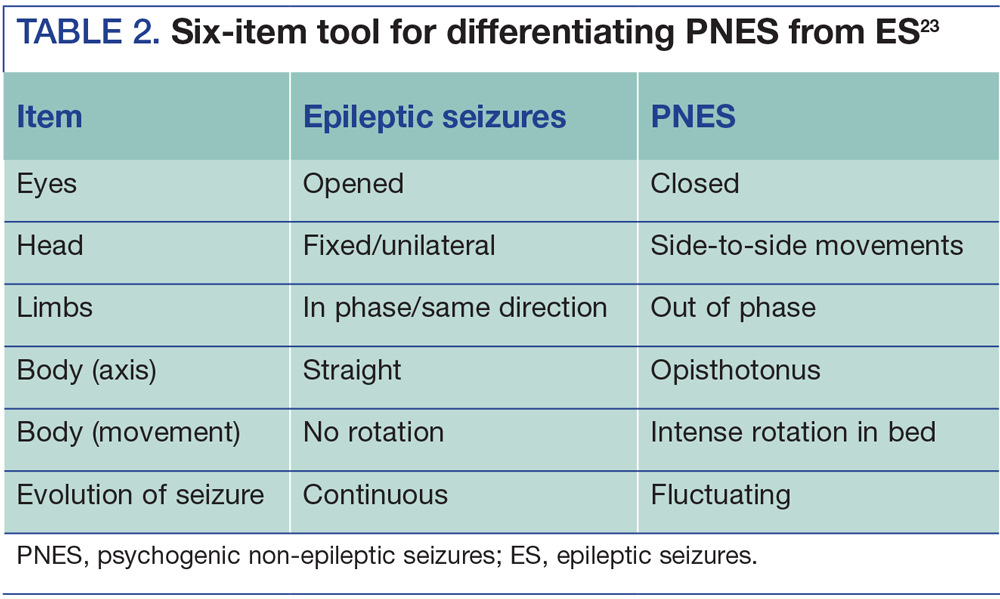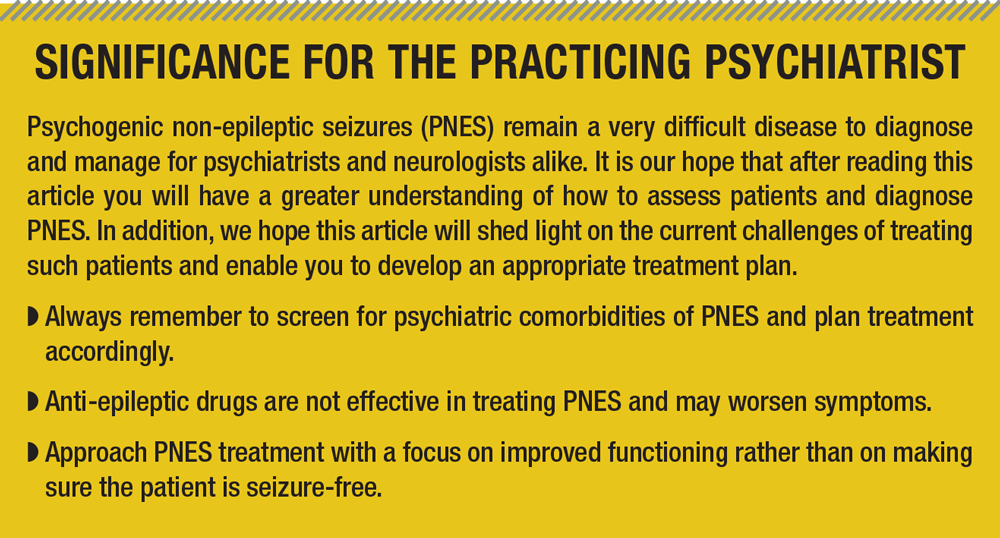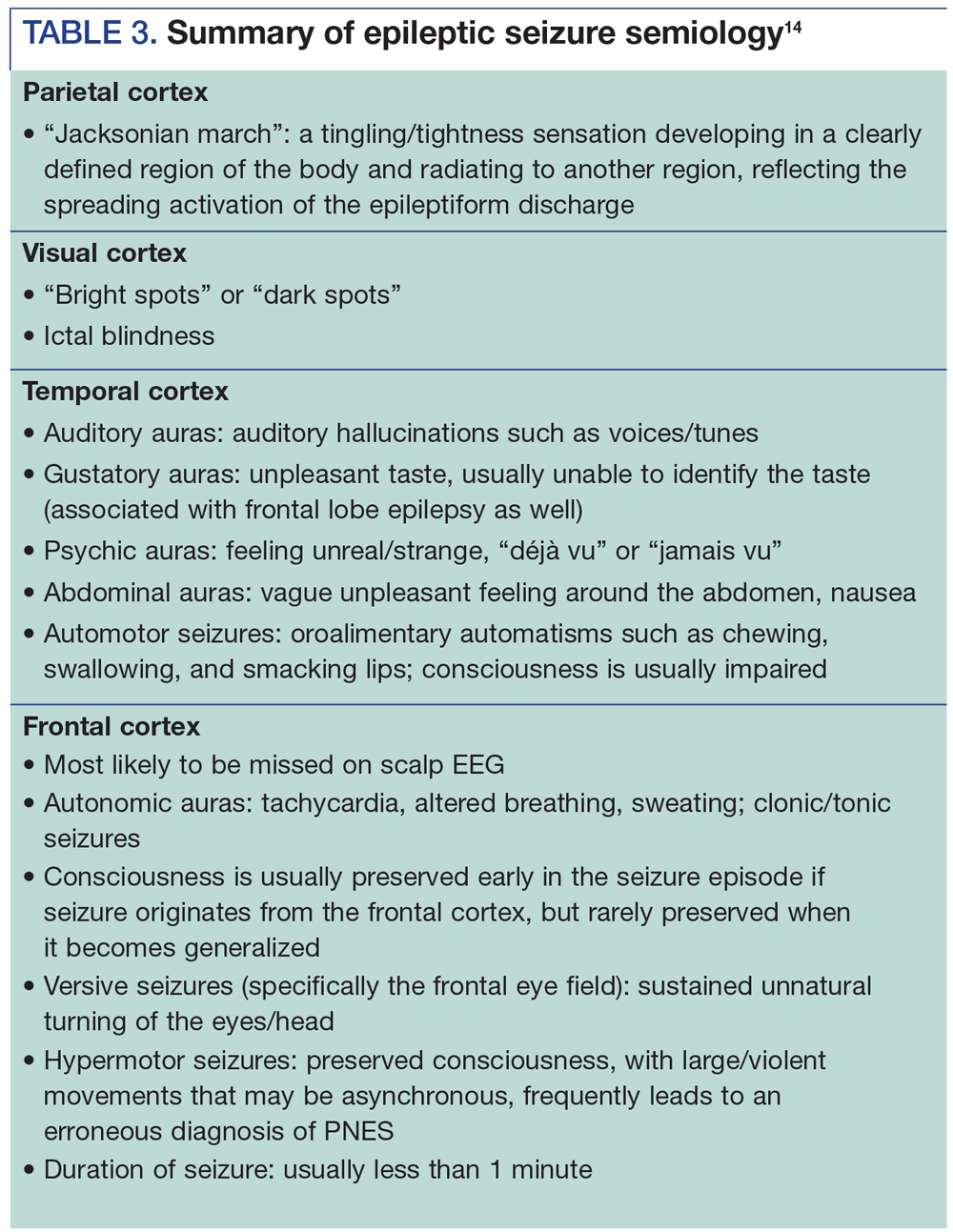Publication
Article
Psychiatric Times
Psychogenic Non-Epileptic Seizures: Clinical Issues for Psychiatrists
Author(s):
The authors shed light on a disorder that is difficult to diagnose and manage, and offer insights on how to develop an appropriate treatment plan.
TABLE 1.

Assessment and Treatment

TABLE 2.

SIGNIFICANCE FOR THE PRACTICING PSYCHIATRIST

TABLE 3.

Although psychogenic non-epileptic seizures (PNES) are events that appear to be similar to seizures, they are not caused by abnormal electrical brain activity. Instead, they are thought to have an underlying psychological cause.
PNES is classified as a subtype of conversion disorder under the category, somatic symptom and related disorders in DSM-5. When coding for PNES as a conversion disorder using ICD-10, the diagnosis must include the specifier “with attacks or seizures” (ICD-10 code F44.5) to differentiate it from other conversion symptoms (eg, dysarthria, sensory loss), which are coded separately. Alternate names frequently used for PNES are non-epileptic attack disorder, functional seizures, stress seizures, psychogenic seizures, and pseudoseizures. The last has largely fallen out of favor because of the pejorative nature of the term “pseudo,” which may imply that the symptoms are not real and therefore undermine the impact of the disorder on a patient’s life. It is not uncommon to see both PNES and epileptic seizures in the same patient.
PNES has a long history in the medical literature, where it has been described by several aliases, the most common being hysteria. Equally as varied were the many hypotheses for the causes of hysteria. Because of its observed frequency in females, hysteria was conceptualized as the result of a “wandering uterus” that had been displaced in the body and subsequently inhabited other organs and appendages, applying pressure and leading to the manifestation of physical symptoms. This theory eventually lost prominence as symptoms of hysteria were increasingly reported in males.
Related content:
Update on Psychogenic Nonepileptic Seizures
In the 19th century, the phenomenon became a passion of French neurologist Jean Charcot, who identified it primarily as a neurological disorder with psychological underpinnings that could, in some cases, be treated by hypnosis. Sigmund Freud, after studying under Charcot, theorized the symptoms as a conversion of repressed libidinal impulses into physical form, which brought about its current title of conversion disorder. Alternatively, Pierre Janet suggested hysteria was more of a dissociative phenomenon that occurred at times of stress with the purpose of allowing an individual to re-experience a traumatic event while separating the memory from conscious awareness.
Assessment
Clues to a possible diagnosis of PNES can be discovered by eliciting a seizure history including onset, typical semiology of the seizure, and treatment. Patients with PNES are likely to have seizures more frequently with more hospital visits than patients with epilepsy. They may often carry a diagnosis of refractory epilepsy, and it is not uncommon for patients to have current or past prescriptions of antiepileptic drugs. Antiepileptic drugs, however, are not effective in treating PNES and may either worsen the symptoms or cause only a transient partial response.
Psychiatric comorbidity is quite common in patients with PNES. The most frequently co-occurring disorders are PTSD, anxiety disorder, personality disorder, and depression (Table 1). Patients with comorbid psychiatric disorders may also have more severe dysfunction and higher levels of stress. Identifying a comorbid psychiatric condition can result in more specific treatments that target those symptoms as well as better outcomes for patients.
In addition to performing a psychiatric review of systems, inquire about any history of medically unexplained symptoms (hand tingling, paralysis, etc) and screen for possible somatoform disorders. Patients with PNES may frequently report pain as other somatic symptoms. Prescriptions for pain medication were found to have a positive predictive value of 76.9% in patients with PNES compared with patients with epilepsy.1
Attempts to identify typical psychological features of PNES have been largely unsuccessful. La belle indifférence, coined by Freud in his observation of patients with conversion disorder, has been thought to be a classic characteristic; however, a systematic review of the literature found this feature was observed in only a minority of those with conversion disorder and not at a significantly higher rate than in controls.2 Alexithymia was thought to be more common in this patient population but has been found to occur at similar rates in patients with PNES and in patients with epilepsy or other medical disorders.3 Patients with PNES can be divided based on problems with emotional regulation: one group has a tendency toward emotional dysregulation, and the other is emotionally over-regulated.4
The precipitating psychological stressor criterion to confirm a diagnosis of PNES was removed from the criteria for conversion disorder in DSM-5. Rates of precipitation trauma are between 44% and 100% in patients with PNES; however, most patients do not report a trigger or stressor during the initial psychiatric assessment. That is not to say traumatic factors will not be discovered once the patient engages in treatment. Lifetime physical and sexual abuse in particular are reported at rates of 23% to 77% and childhood sexual or physical abuse at 32.4% to 88%.5,6 Outside of abuse, bereavement and being in or witnessing an accident are other possible antecedent factors. Early-onset (adolescence) PNES has been associated with bullying; late-onset PNES has been associated with health-related trauma.7
When assessing triggers, keep in mind that one-third of epilepsy patients also report childhood physical or sexual abuse. Moreover, stress can trigger epileptic seizures.
Diagnosis
The gold standard for diagnosing PNES is continuous video electroencephalography, or vEEG. This should be done only after carefully eliciting a description of the typical seizure presentation, also known as semiology, from the patient or a family member. Only a video recording that captures an episode resembling the reported semiology with no concomitant epileptiform activity seen on EEG (vEEG) can be used to make a definitive diagnosis. If multiple seizure types are reported, then each type of seizure should be visualized on vEEG because of the possible co-occurrence of PNES with epileptic seizures.
vEEG usually requires inpatient admission to an epilepsy monitoring unit, which is not found at all hospitals. Such admissions are also costly and may have long wait times. However, a routine EEG that lasts 20 to 30 minutes has a 1% chance of capturing even an epileptic seizure and is an insufficient substitute. Ambulatory EEG has also not been shown to be a reliable diagnostic test for PNES. The Nonepileptic Seizures Task Force for the International League Against Epilepsy published a staged diagnostic approach to PNES.8 Some of their recommendations are reviewed here; however, we encourage readers to refer to the article for a more comprehensive review.
When vEEG is not available, a seasoned clinician could possibly diagnose PNES by observing specific semiology alone. Bedside tools based on data from several studies have been created to aid in visual diagnosis of PNES episodes (Table 2). However, the studied semiologic differences are specifically between convulsive-type PNES and generalized tonic-clonic (GTC) seizures. PNES as well as epileptic seizures have various presentations (eg, absence seizures, frontal seizures) that significantly reduce the ability to diagnose PNES by observation alone and can lead to misdiagnosis. In such cases, a push for vEEG referral by the consulting psychiatrist is warranted.
In regards to observed semiologic differences, convulsion-type attacks in PNES tend to be asymmetrical and asynchronous, have a more fluctuating inconsistent course, and may respond to bystander intervention. Preserved awareness during events, especially with bilateral limb movements, should raise suspicion for PNES. Pelvic thrusting has been observed more frequently in PNES; however, it can occur in GTC seizures as well. Side-to-side head and body movement along with eye and mouth closure have been more readily associated with PNES than with GTC seizures. Urinary incontinence and tongue biting have not been shown to be useful in differentiating PNES from GTC seizures. The latter rarely last more than 2 minutes.
Post-ictally, patients with PNES are more likely to regain awareness quickly, recall the seizure event, and not have symptoms of fatigue or headache. PNES episodes are also more typically followed by rapid shallow breathing that quickly subsides, whereas GTC seizures are frequently followed by prolonged harsh, loud, deep breathing.
Non-epileptic status, a prolonged episode of seizure-like symptoms that lasts more than 30 minutes, was reported by one-third of patients in one study.9 However, unlike status epilepticus, non-epileptic status does not pose an imminent risk of brain injury.
Along with semiology, there are a handful of soft signs that may heighten suspicion of PNES. One is the teddy bear sign, in which an adult patient keeps a stuffed animal in the hospital bed. The specificity of this soft sign was rated highly by a retrospective chart review.10 However, a prospective study that looked at the presence of a stuffed animal at the time of admission in 264 patients found that of the 34 patients who presented with a stuffed animal, 56% had a diagnosis of epilepsy and 39% had a diagnosis of PNES, which gives the sign poor predictive value.11
Another soft sign for PNES is the number of allergies a patient reports. Independent of other risk factors, patients who reported more than 12 allergies had a 6-fold higher likelihood of a PNES diagnosis.11-13
Differential diagnosis
As mentioned above, one of the conditions in the differential diagnosis of PNES is epilepsy. Table 3 summarizes various sites of seizure origin and likely semiology. (For a more complete description of epileptic semiology, see the article by Noachtar and Peters.14)
Another condition in the differential may be periodic limb movements of sleep, which are highly correlated with restless legs syndrome. They occur only during sleep with very repetitive, stereotyped limb movements; are more likely to involve the lower extremities; and can be bilateral.
Up to 13% of patients who are referred to an epilepsy clinic may have neurocardiogenic syncope, a syndrome that can mimic epileptic seizures. There are multiple precipitating factors, one of which is emotional stress. On rare occasions, patients can have seizure-like activities during syncopal episodes. Patients would likely lose consciousness first and fall before uncontrolled muscle movements.
Factitious disorder and malingering
It is important to recognize when seizure-like symptoms are being volitionally produced for the purpose of maintaining a sick role or for secondary gain. Unfortunately, vEEG may not be able to separate conversion disorder from factitious disorder. However, a study that looked at the possibility of physical symptoms in PNES serving as an unconscious motivation to acquire “the sick role” found that there were no differences between patients with PNES and controls in attitudes toward illness or the desire to be sick.15
While the desire to maintain a sick role in factitious disorder may be unconscious, the act of deception itself is conscious and purposely perpetrated. Clinical scenarios that may heighten suspicion of factitious disorder are those where the symptoms seem to occur or increase in severity when requests for unnecessary interventions are declined by the treatment team. Another example is a sudden increase in seizure frequency when a patient is informed that discharge from the hospital is imminent.
Prognosis
The prognosis of the disorder, like its etiology, is varied. With no intervention, slightly more than one-third of 260 patients with PNES were seizure-free at 1-year follow-up.16 Psychological factors that predict poor prognosis include dissociative tendencies, somatization, negativism, and depression. Keep in mind, however, that seizure frequency may not always correlate with quality of life, and patients who are seizure-free with untreated comorbid psychiatric disorders may be as impaired as those who continue to experience seizures.
Patients with PNES who receive the diagnosis without any intervention continue to be high health care utilizers; however, the chief complaint becomes pain rather than seizures.17 The frequency of total outpatient visits, while also unchanged, shifts in specialty with patients having frequent visits to outpatient psychiatry clinics rather than neurology. Having an internal locus of control and being currently employed were the 2 factors found to predict a reduction in health care utilization.18
Treatment
There has been a recent focus on psychoeducation and cognitive behavioral therapy (CBT) as primary methods for first-line interventions in patients with PNES. Most of the available small randomized clinical trials have shown positive results. There is also some evidence for the effectiveness of psychodynamic and mindfulness-based therapies. These specific forms of intervention may be useful if either first-line intervention is not effective or the evaluating psychiatrist deems it appropriate given the underlying psychological stressor.
Research into pharmacological treatment for PNES has focused on SSRIs as first-line treatment. LaFrance and colleagues19 randomized 34 patients to CBT only, CBT with flexible-dose sertraline, antidepressant only, and treatment as usual. Patients in the CBT-only group and the CBT-plus-flexible-dose-sertraline group showed a significant reduction in seizure frequency. In another study comprising 38 patients, LaFrance and colleagues20 found no statistical difference in the SSRI group and placebo group in seizure reduction. However, a within-group analysis showed a 45% reduction in seizure events in the SSRI group at 12 weeks.
The results from a small (N = 19) open-label, 5-month prospective study of patients with PNES showed that venlafaxine reduced the number of seizures by more than 50% in 15 patients with an average dose of 189.71 mg daily.21 It should be noted that participants with psychiatric comorbidities were not excluded from SSRI studies.
There is a possibility that the use of antidepressants in PNES could improve outcomes by treating comorbid psychiatric issues rather than by having a direct effect on PNES. The quest for a pharmacological solution for PNES will have to continue. Much more research is needed before we have a first-line pharmacological treatment specifically for PNES.
Conclusion
While there have been strides over the years in our ability to diagnose PNES, its etiology and treatment remain elusive. It is imperative, however, that psychiatrists assist in early diagnosis and treatment interventions to decrease the severity of burden from this disorder. The current empirical studies may help us discover what Charcot alluded to in his anecdotal experiences-that PNES may be a symptom of a variety of mental and biological processes rather than a specific disorder unto itself, requiring personalized treatments instead of a one-size-fits-all intervention. The goal for PNES treatment may also not be the complete elimination of seizures, but rather a focus on seizure reduction and patient functioning.
Disclosures:
Dr. Abbasi is Consulting Psychiatrist for the Jefferson Comprehensive Epilepsy Center, and Assistant Professor, Psychiatry and Human Behavior, Sidney Kimmel College of Medicine at Thomas Jefferson University Hospitals, Philadelphia, PA. Dr. TsungWai is a Second-Year Resident, Department of Psychiatry and Human Behavior, Thomas Jefferson University Hospitals. The authors report no conflicts of interest concerning the subject matter of this article.
References:
1. Gazzola DM, Carlson C, Rugino A, et al. Psychogenic nonepileptic seizures and chronic pain: a retrospective case-controlled study. Epilepsy Behav. 2012;25:662-665.
2. Stone J, Smyth R, Carson A, et al. La belle indifférence in conversion symptoms and hysteria: systematic review. Br J Psychiatry. 2006;188:204-209.
3. Brown RJ, Reuber M. Towards an integrative theory of psychogenic non-epileptic seizures (PNES). Clin Psychol Rev. 2016;47:55-70.
4. Brown RJ, Reuber M. Psychological and psychiatric aspects of psychogenic non-epileptic seizures (PNES): a systematic review. Clin Psychol Rev. 2016; 45:157-182.
5. Fiszman A, Vieira S, Leon A, et al. Traumatic events and posttraumatic stress disorder in patients with psychogenic nonepileptic seizures: a critical review. Epilepsy Behav. 2004;5:818-825.
6. Reuber M. Psychogenic nonepileptic seizures: answers and questions. Epilepsy Behav. 2008; 12:622-635.
7. Duncan R, Oto M. Predictors of antecedent factors in psychogenic nonepileptic attacks: multivariate analysis. Neurology. 2008;71:1000-1005.
8. LaFrance WC Jr, Baker GA, Duncan R, et al. Minimum requirements for the diagnosis of psychogenic nonepileptic seizures: a staged approach: a report from the International League Against Epilepsy Nonepileptic Seizures Task Force. Epilepsia. 2013; 54:2005-2018.
9. Reuber M, Pukrop R, Mitchell AJ, et al. Clinical significance of recurrent psychogenic nonepileptic seizure status. J Neurol. 2003;250:1355-1362.
10. Burneo JG, Martin R, Powell T, et al. Teddy bears: an observational finding in patients with non-epileptic events. Neurology. 2003;61:714-715.
11. Robbins NM, Larimer P, Bourgeois JA, Lowenstein DH. Number of patient-reported allergies helps distinguish epilepsy from psychogenic nonepileptic seizures. Epilepsy Behav. 2016:174-177.
12. Park JH, Bokma J, Chapple K, Caplan JP. A retrospective study of polyallergy as a marker of nonepileptic seizures in the epilepsy monitoring unit. Psychosomatics. 2014;55:566-571.
13. Reeves AL, McAuley JW, Moore JL, Capestany J. Medication use, self-reported drug allergies, and estimated medication cost in patients with epileptic versus nonepileptic seizures. J Epilepsy. 1998; 11:191-194.
14. Noachtar S, Peters AS. Semiology of epileptic seizures: a critical review. Epilepsy Behav. 2009; 15:2-9.
15. Testa SM, Brandt J. Do patients with psychogenic nonepileptic seizures have positive covert attitudes toward sickness? Epilepsy Behav. 2010;19:323-327.
16. McKenzie P, Oto M, Russell A, et al. Early outcomes and predictors in 260 patients with psychogenic nonepileptic attacks. Neurology. 2010;74: 64-69.
17. Salinsky M, Storzbach D, Goy E, et al. Health care utilization following diagnosis of psychogenic nonepileptic seizures. Epilepsy Behav. 2016;60: 107-111.
18. Duncan R, Anderson J, Cullen B, Meldrum S. Predictors of 6-month and 3-year outcomes after psychological intervention for psychogenic non epileptic seizures. Seizure. 2016;36:22-26.
19. LaFrance WC Jr, Baird GL, Barry JJ, et al. Multicenter pilot treatment trial for psychogenic nonepileptic seizures: a randomized clinical trial. JAMA Psychiatry. 2014;71:997-1005.
20. LaFrance WC Jr, Keitner GI, Papandonatos GD, et al. Pilot pharmacologic randomized controlled trial for psychogenic nonepileptic seizures. Neurology. 2010;75:1166-1173.
21. Pintor L, Bailles E, Matrai S, et al. Efficiency of venlafaxine in patients with psychogenic nonepileptic seizures and anxiety and/or depressive disorders. J Neuropsychiatry Clin Neurosci. 2012;22:401-408.
22. Diprose W, Sundram F, Menkes DB. Psychiatric comorbidity in psychogenic monepileptic seizures compared with epilepsy. Epilepsy Behav. 2016; 56:123-130.
23. DePaola L, Terra VC, Silvado CE, et al. Improving first responders’ psychogenic nonepileptic seizures diagnosis accuracy: development and validation of a 6-item bedside diagnostic tool. Epilepsy Behav. 2016;54:40-46.






